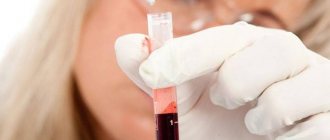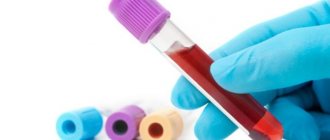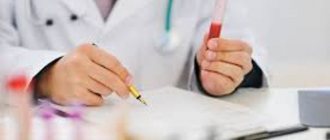The normal functioning of all systems and organs of the human body is determined by the balance of microelements and vitamins, which, of course, are useful and necessary substances.
A blood test for the amount of such substances is recognized as one of the most important tests, which helps to assess the patient’s health status. With the help of this study, the doctor determines how harmoniously the entire body functions as a whole and diagnoses many diseases at the initial stage of their development.
Description of the study
A blood test for the content of vitamins and microelements allows diagnostics to be carried out with a high degree of efficiency. It characterizes not only the state of health in general, but also shows various pathologies in the body, for example:
- Inflammatory processes in a progressive stage.
- Rheumatoid changes of various types.
- Failure in the water-salt balance of the body.
Among other things, the result of the study shows the functional state of human organs and systems. A blood test for microelements and vitamins helps confirm an existing diagnosis, as well as determine the necessary drug therapy. If the attending physician considers it necessary to undergo this type of analysis to complete information about the state of the body, then you should not neglect his recommendation and refuse the study.
The functioning of organs and systems in a normal state occurs by maintaining the balance of all necessary nutrients, including trace elements and vitamins. These elements take an active part in metabolic processes, are part of several enzymes and affect the functioning of almost all systems of the body as a whole.
If a certain group of vitamins or microelements is present in the body in insufficient quantities, this provokes the development of certain diseases.
Decoding the results
Each of the vitamins and microelements is responsible for certain metabolic processes. Not only a deficiency, but also an excess of certain elements can pose a health hazard.
Vitamin content standards
The table below shows normal concentrations of vitamins and pathologies with their deficiency or excess content.
| Vitamin | Normal values | Pathologies due to hypovitaminosis | Pathologies due to hypervitaminosis |
| A (retinol) | 0.3 – 0.8 µg/ml | Impaired twilight vision, fragility of tooth enamel, bones, skin rashes | Oncological diseases, fetal pathologies in pregnant women |
| B1 (thiamine) | 2.1 – 4.3 ng/ml | Mental disorders, heart rhythm disturbances, tendency to edema, exhaustion | None |
| B2 (riboflavin) | 137 – 370 ng/ml | Dry and brittle hair as a result of deterioration of the sebaceous glands, fatigue, inflammation of the oral mucosa (stomatitis) | None |
| B3 (PP, nicotinic acid) | 3 – 36 ng/ml | Digestive disorders, neurological disorders, diarrhea, skin rash | Hyperemia (dilation of blood vessels) of the skin of the body and face, arrhythmia, increased sweating, skin irritation, impaired coordination of movements |
| B5 (pantothenic acid) | 0.2 – 1.8 µg/ml | Skin roughening, peeling, seborrhea, neurological disorders, hypochromic anemia | Polyneuritis (inflammation of many nerves) |
| B6 (pyridoxine) | 8.7 – 27.2 ng/ml | ||
| B9 (folic acid) | 2.5 – 15 ng/ml | Anemia with enlarged forms of red blood cells (megaloblasts), impaired development of the nervous system in the fetus | None |
| B12 (cobalamin) | 189 – 833 ng/ml | Hematopoietic disorders (megaloblastic forms of red blood cells), autoimmune gastritis, pernicious anemia, atrophic gastritis, spinal cord damage | None |
| C (ascorbic acid) | 4 – 20 µg/ml | Scurvy (bleeding gums, periodontal disease), bleeding disorders and fragility of the vascular wall (nosebleeds, subcutaneous hemorrhages), weakened immune response, impaired bone development in childhood | Absent |
| D (calciferol) | 3 – 49 ng/ml | Rickets, cardiovascular diseases, immune disorders, kidney pathologies | Poisoning, calcium deposition in tissues |
| E (tocopherol) | 5 – 18 µg/ml | Impaired muscle contractility, infertility, miscarriages | Poisoning |
| K (naphthoquinone) | 0.1 – 2.2 ng/ml | Increased bleeding | Red blood cell breakdown, poisoning, jaundice |
Usually, an excess of water-soluble vitamins (C, group B) has almost no effect on health, since they are quickly excreted by the kidneys. An increased concentration of fat-soluble vitamins (A, D, E, K) is considered dangerous, since they are excreted by the liver and can accumulate in the body.
Norms for microelements content
The table below presents the most commonly identified microelements and pathologies associated with their excess or deficiency.
| Microelement | Normal values | Pathologies due to deficiency | Pathologies with excess |
| Iron | 9 – 31 µmol | Anemia | Erythrocytosis, blood thickening |
| Copper | 0.75 – 1.8 µg/ml | Osteoporosis, pigment metabolism disorders, bone and joint diseases | Poisoning, Konovalov-Wilson disease |
| Cobalt | 0.00045 – 0.001 µg/ml | Megaloblastic and pernicious types of anemia | Poisoning |
| Selenium | 0.07 – 0.12 µg/l | Weakened immunity, mental disorders, oncology | Poisoning |
| Manganese | 0.007 – 0.015 µg/ml | Multiple sclerosis, diabetes mellitus, vitiligo, osteoporosis | Rickets, hypothyroidism, neurological pathologies |
| Iodine | 2 – 50 µg/ml | Thyroid pathologies | Impaired memory, attention, developmental delay in children |
A blood test for vitamins and microelements takes from one to 10 working days, depending on the number of indicators determined.
Gorelova Yulia Andreevna
Indications for the study
The main signs of an imbalance in the level of vitamins and microelements are anemia, fatigue, decreased memory and protective properties of the body, as well as apathy. A blood test for a lack of vitamins and microelements belongs to a group of biochemical studies that help assess the general condition of the body.
It also helps determine the excess or deficiency of a particular microelement.
Indications for referral for a blood test for vitamins are:
- Characteristics of human nutrition in terms of the content of essential microelements.
- Diagnosis of various types of diseases, the development of which inevitably affects the level of concentration of nutrients.
- Checking the effectiveness of therapy carried out with metal-containing medications.
- Preventive examination of patients who are at increased risk.
- Therapeutic control in case of need for artificial ventilation, dialysis and parenteral nutrition.
- Detection of intoxication of the body with heavy metals in chronic or acute form.
For all of the above indications, the patient is sent for a blood test for vitamins and microelements.
Reference values of vitamins in the body
Most of us know the importance of maintaining normal levels of vitamins in the blood. But this will not be possible if you do not know what the optimal values of these substances should be.
Retinol
Retinol, or vitamin A, is a substance responsible for the functions of the skin and eyes. Its normal value: 0.3 - 0.8 μg/ml.
B vitamins
The level of vitamin B in the blood is of vital importance, since this element takes part in almost all processes occurring in the human body. There is a separate gradation of this group for substances, so the standards may differ
| Vitamin name | Minimum (ng/ml) | Maximum (ng/ml) |
| B1 (thiamine) | 2,1 | 4,3 |
| B2 (riboflavin) | 137 | 370 |
| B3 (nicotinic acid) | 3 | 36 |
| B5 (panthenol) | 0,2 | 1,8 |
| B6 (pyridoxine) | 8,7 | 27,2 |
| B9 (folic acid) | 2,5 | 15 |
| B12 (cyanocobalamin) | 189 | 833 |
Vitamin C
It's no secret why the human body needs ascorbic acid. Maintaining immunity and gastrointestinal tract activity is the main task of this substance. And it can perform these functions only if its indicators are 4 - 20 mcg/ml.
Vitamin D
Everyone probably knows about the need for this element. But not everyone knows what a vitamin D test is called. Therefore, if the patient sees o on the referral form, he must understand that this is vitamin D3. Its normal values should not be lower than 3 ng/ml or higher than 49.6 ng/ml.
Vitamin E
Tocopherol is one of those substances that is involved in the activity of the nervous, reproductive, and endocrine systems
That is why it is so important to maintain its concentration at a normal level. Reference values for this vitamin are from 5 to 18 mcg/ml
Vitamin K
The main function of this element is the regulation of the circulatory system. Therefore, this substance must be present in the analysis scheme for a lack of vitamins in the body. Its normal values are 0.1 - 2.2 ng/ml of blood.
Analysis of the vitamin and mineral profile is a study that is recommended for every patient to undergo from time to time. Timely identification of a deficiency or excess of a particular substance makes it possible to begin therapy in a timely manner, thereby preventing the occurrence of more serious health problems.
Description of trace elements
Microelements are those chemical substances that take a significant part in performing functions vital for the body. Their deficiency or, on the contrary, excess, leads to disruptions in the functioning of all tissues and systems. This causes severe diseases, disruption of human well-being and pathological complications.
The amount of microelements present in the body is quite large. However, the most important and necessary are those described below.
Indicators and their standards
Norm of microelements in the blood:
| Name | Minimum level | Maximum level | ||
| Calcium | 2.05 | 2.5 | ||
| Chlorine | 96 | 111 | ||
| Potassium | 3.2 | 5.1 | ||
| Sodium | 132 | 147 | ||
| Iron | women 7.2 | Men 10.7 | women 25.9, | men 28.6 |
| Phosphorus | 0.87 | 1.34 | ||
| Magnesium | 0.67 | 1.1 | ||
When deciphering the results of the ionogram, first of all, the possible reasons for deviations from the stated standards are taken into account. If necessary, patients are prescribed additional studies to clarify the results obtained.
Calcium
Contributes to the normal functioning of the entire human body, and its deficiency can lead to the development of tachycardia, arrhythmia and other pathological conditions. If a person lacks calcium, there is a possibility of muscle soreness, decreased visual acuity, intestinal problems and irritability. An increased calcium content also has a detrimental effect on the functioning of the body, in particular causing muscle hypotonicity, deformation of the bone structure and disruptions in the coordination system of movements.
Copper
The highest concentrations of this trace element can be found in the kidneys, brain and heart. A decrease in the level of this substance in the blood can cause anemic symptoms. Copper deficiency in the blood of a premature baby can cause psychomotor impairment. An excess provokes pathologies such as vomiting and nausea, as well as hemolytic anemia and liver failure. All these symptoms indicate a severe degree of copper intoxication in the body and require immediate medical intervention.
Vitamin A
There are a number of manifestations of malaise characteristic of a lack of carotenoids:
- pale, dry skin;
- vision problem;
- susceptibility to infections;
- fatigue and so on.
But these symptoms are characteristic of many diseases that are not associated with changes in retinoid levels.
Therefore, before starting treatment, you need to contact a specialized organization to conduct clarifying testing.
Zinc
This trace element greatly affects the hormonal balance in the body and promotes puberty. In addition, zinc is a substance that helps the absorption of proteins, fats and carbohydrates, that is, it stimulates metabolic processes. If its concentration is insufficient, this can cause increased fatigue, overexcitation of the nervous system, and in some cases lead to infertility. Excessive amounts of the substance can cause delays in the growth and development of the child.
How to prepare
When preparing for an ionogram, doctors recommend limiting the use of medications that contain ions.
This must be done 3 days before the study. It is also necessary not to eat food 8 hours before the collection, not to smoke for an hour, and not to drink alcohol for 24 hours.
In 15-20 minutes, if possible, eliminate any worries.
Carrying out analysis
All of the microelements listed above are important for the normal functioning of the human body. It is under the influence of these substances that all systems and structures function according to a system streamlined by nature.
An imbalance in the content of microelements can be caused by stress, poor nutrition, prolonged exposure to direct sunlight and an unfavorable environment.
All these factors also affect the level of microelements, which subsequently leads to the following changes:
- Decreased immune properties of the body.
- Disruption of the nervous system and thyroid gland.
- The emergence of cancer.
- Development of inflammatory processes.
A comprehensive analysis of microelements and vitamins is a simple and effective way to diagnose various pathologies and prevent their development.
Large screening of the elemental composition of hair (40 microelements)
Analysis of hair for trace elements can give an idea of the content of 40 elements in the body, including: aluminum, iron, iodine, gold, potassium, calcium, magnesium, copper, silver, phosphorus, zinc, antimony, selenium, nickel, tin, sodium, rubidium , boron, beryllium, vanadium.
The presence of elements such as barium, tungsten, bismuth, cadmium, cobalt, silicon, lithium, lanthanum, manganese, molybdenum, sodium, arsenic, platinum, tin, nickel, rubidium, mercury, strontium, antimony, lead, chromium, thallium is also noted and zirconium.
Features of diagnostics based on the results of spectral analysis of hair
Profile No. ME10 includes the maximum list of both macroelements and microelements. Recommended as a preventive study or as a general diagnostic program. It is recommended that if the Profile of analysis results deviate from the reference values, assign profiles that assess the current exchange of ME in the body: No. ME3 (serum, whole blood) and No. ME4 (urine) or separate tests for these biosubstrates. However, it is worth noting that the diagnostic utility of some tests is limited and difficult to interpret.
Comparing the analysis of ME in hair with their analysis in blood and urine, it should be noted that the concentration of ME in hair is significantly higher than in the above-mentioned substrates. Hair does not require special storage conditions and meets the principles of non-invasiveness when selecting material. Unlike liquid biosubstrates, the concentration of ME in hair is less subject to strict homeostatic regulation (only up to the border of the hair papilla zone and the medullary part of the hair itself, which quickly undergoes “death” and stops exchange with the internal environment of the body) and short-term changes in the content of ME in liquid biosubstrates, depending on the supply of ME from outside. In this regard, according to a number of authors, hair should be considered as a prenosological diagnosis and early detection of pathological changes in the body associated with a deficiency or excess of ME in tissues.
It is especially worth noting (necessary for understanding the analysis of elemental metabolism in the body) that the dynamics of ME deposition in mobile cellular elements of whole blood does not always coincide with the dynamics of ME distribution in slowly exchanging structures: hair and nails (including in non-analyzed structures - parenchymal organs, bones, cartilage. This is due to the anatomical and physiological characteristics of the kinetics of ME distribution between compartments of the body.
Hair analysis “mirror” reflects the endogenous tissue content for a number of MEs, the level of excretion from the body, especially for toxic MEs (figuratively “hair buds”), as well as exogenous exposure (the chemical structure of the substance that contains the ME being determined should be taken into account). Also, to assess the elemental composition of hair, it is necessary to take into account such factors as the rate of hair growth and the influence of environmental factors.
WHY DO YOU NEED A MINERALOGRAM?
This type of diagnosis is required to obtain accurate information about the patient’s health status. He evaluates:
- nutritional balance;
- influence of bad habits and ecology on the body;
- condition of internal organs;
- quality and completeness of metabolic processes;
- excess and deficiency of nutrients when prescribing dietary supplements.
As a rule, the analysis time does not exceed 10 days. In some cases, the period may be shortened to 7 days or extended to 2 weeks.
Indications for the procedure
The most common reasons for the need for spectral hair diagnostics include:
- weakened immune system;
- frequent manifestation of respiratory and viral diseases;
- the presence of allergic reactions;
- insufficient effectiveness of therapy used to treat problems of the circulatory system;
- nervousness:
- deviations in the gastrointestinal tract;
- infertility;
- impotence;
- disruptions in the functioning of the thyroid gland;
- increased stress on the body of any nature;
- unbalanced diet;
- danger or harmfulness of work;
- being in a place with increased radioactivity or poor ecology;
- osteoporosis;
- deterioration of the hair and epidermis.
It is also useful to carry out the procedure for those who are on a diet, have insufficient body weight and vision problems.
Execution technology
Inductively coupled argon plasma mass spectrometry (ICP-MS)
In laboratory conditions, the sample is cleaned of fat with acetone, washed with distilled water and dried twice. The prepared material is weighed and transferred to a special container, where nitric acid and water are added in certain proportions. The mixture dissolves the hair. The resulting mass is placed into the spectrometer, simultaneously brought into contact with argon gas.
The research is carried out at high temperatures, and when the sample is exposed to plasma, the material burns. The signal received by the analyzers is converted into an electronic diagram by special programs. The results obtained are compared with normal ones.
Analysis report
In the analytical report, a mineralogram is constructed that reflects the real ratio of microelements in the body in comparison with the reference one.
If small discrepancies are found, doctors can adjust the diet and, if necessary, supplement it with dietary supplements. In the case of a significant imbalance, as a rule, a referral is issued to the doctor who is responsible for the specific case (most often to an endocrinologist, cardiologist or toxicologist).
Preparation
Preparation for analysis plays an important role in the reliability of the results obtained. Therefore, you should not neglect the recommendations of specialists in this regard.
Blood is drawn from a vein, strictly on an empty stomach in the morning. In order for the indicators to be reliable, the following instructions must be followed:
- You cannot eat before donating blood, you are only allowed to drink water.
- It is prohibited to drink alcohol on the eve of the test, and it is also necessary to avoid thermal and physical stress.
- Two weeks before the intended blood donation for microelements and vitamins, you must stop taking any medications.
- You cannot take the test immediately after x-rays, injections and massage.
An inquisitive reader will ask where to get tested for vitamins and microelements. The answer is simple: in any medical laboratory.
ANALYSIS FOR MICROELEMENTS AND VITAMINS
Tests for the content of microelements and vitamins: indications for use, norms and causes of deviations
Vitamins and microelements are substances that provide all vital processes in the body without exception. Microelements are biologically significant inorganic elements contained in all living organisms in minimal quantities - 0.001% of body weight. These substances are often confused with vitamins. However, the latter belong to organic substances, although they are no less important for the body. Microelements and vitamins together are involved in all life support processes, and their deficiency or excessive excess leads to dangerous pathological changes. In order to timely identify a deficiency of certain biologically active substances, it is necessary to undergo a special test for vitamins and microelements.
You can often notice how the body, through the desire to consume certain foods, regulates the internal balance of the substances it needs. But, in order to find out more reliably about the internal state, you can do a blood test for vitamins and microelements.
MICROELEMENTS AND VITAMINS
Microelements are classified as inorganic substances, the content of which in the body is about 4% of the total mass of the human body.
Trace elements are divided into metals and non-metals (halogens). They enter the body with food, water, air, and some organs are provided with their own reserves of these biologically significant substances. Vitamins are low molecular weight organic substances. Many of these organic compounds are related to coenzymes or their precursors. The body obtains vitamins from food and the environment. The daily need for vitamins is small, but the supply of these substances should be regular. Because almost all the vitamins necessary for life support are not synthesized by the body, but come from outside.
Deficiency of vitamins and microelements is especially dangerous during the formation of the embryo and for the growing organism, because it leads to underdevelopment of organs and systems. For an adult, in whom all the structures of the body are formed, the deficiency of any vitamin and mineral is not so critical. But over time, the systematic absence of any substance leads to an imbalance in some vital processes. And if the lack of certain vitamins and microelements required by the body is not corrected in time, then over time this can lead to the development of pathologies.
Which vitamins are missing in the blood can be easily determined by conducting laboratory tests. In tests for vitamins and microelements analyzed by the attending physician, a list of values for each test substance will be indicated. Which will give a full-scale picture of the vitamin and mineral balance in the body
PROCEDURE FOR CONDUCTING RESEARCH
To determine the content of vitamins and minerals in the body, various studies are prescribed.
Whole blood or serum, hair, nails, and urine can be used as biomaterial A test for vitamins takes 1 business day, but a comprehensive analysis for microelements takes up to 6 business days. If the study involves taking blood, then you should come to the laboratory in the morning and on an empty stomach (after an 8-hour overnight fast). To submit hair and nails for examination, you must read special instructions (they are usually provided in the laboratory before the analysis), since the process of collecting them requires compliance with many nuances.
WHEN IS A BLOOD TEST REQUIRED?
A comprehensive blood test for vitamins and minerals should be taken in the following situations:
- During the period of planning, bearing and breastfeeding a child.
- A woman after completing the process of breastfeeding a child.
- Representatives of the fairer sex who are prone to heavy menstruation.
- Children in the active growth phase.
- Teenagers during puberty.
- Persons on strict diets.
- People employed in heavy and hazardous industries.
- To everyone who lives in an environmentally unfavorable area.
- For those who are susceptible to chronic pathologies.
- Patients after chemotherapy.
- Individuals exposed to constant stress.
- During the spring and winter months.
- To old people.
A blood test for microelements and vitamins requires certain preparation:
- You will need to come to the laboratory in advance to put your emotional (rest after the road) and physical (calm your pulse, blood pressure) in order.
- At least eight hours must have passed since your last meal.
- In the morning you are allowed to drink water, a little and always only clean water without any additives.
- For about a week, drinking any drinks containing alcohol is prohibited, this applies to both alcoholic and pharmaceutical products.
- On the day of taking a blood test for minerals and vitamins, it is advisable to refrain from smoking.
- To take a blood test correctly and get a reliable result, you cannot combine days of visiting the laboratory and physiotherapeutic (hardware) procedures.
- The laboratory technician or attending physician must be notified if drug therapy is being administered. Most likely, you will need to stop taking medications while blood is drawn to study the levels of vitamins and minerals in the body.
It is possible to obtain distorted examination results if a person is in a state of strong emotional distress. Intense physical activity also does not have the most favorable effect on blood composition. This applies not only to people involved in heavy physical labor, but also to athletes.
INTERPRETATION OF THE RESULTS OBTAINED
Modern medicine reliably knows a list consisting of 13 vitamins (water- and fat-soluble) and 16 microelements.
Of the microelements, nine substances have essential status. Vital microelements include: I (iodine), Fe (iron), Mn (manganese), Co (cobalt), Mo (molybdenum), Cr (chromium), Se (selenium), Zn (zinc), Cu (copper) . The norm of each substance must be present in the blood at all times. When normal levels of vitamins or minerals fail to decrease or increase, pathologies begin to develop in those organs and systems for which certain useful particles are responsible. Pathologies due to a lack of vitamins and microelements:
- Dysbacteriosis;
- Tendency to anemia, various types of anemia;
- Weakness of the immune system;
- Excess weight;
- Development of diabetes;
- Loss of hair on the head;
- Skin diseases;
- Digestive disorder;
- Pathologies of bones and joints;
- Cardiovascular diseases;
- Disorders of the nervous system (central and peripheral);
- Slow development in children;
- Weakening of sexual and reproductive function.
This is only a partial list of pathologies that arise as a result of a deficiency of nutrients. The clinical picture of vitamin and mineral deficiency is especially pronounced if a person has a tendency to bleed, as well as after chemotherapy. This procedure, aimed at destroying malignant cells, causes enormous damage to the entire body. Therefore, after chemotherapy, to restore the balance of vitamins and microelements, you will need to take special complexes and, in addition, fruits and vegetables. But not only for recovery after chemotherapy, increased intake of mineral and vitamin complexes is recommended. A diet, as well as taking medications with a certain content of vitamins and microelements, depending on the specific need for a particular substance, is indicated in many cases.
Often, doctors and patients themselves do not associate diseases with a lack of any elements, but such a problem is quite easy to eliminate by simply changing the diet or prescribing appropriate vitamin and mineral complexes. However, before you run to the pharmacy, you should take a test for vitamins and microelements and take the results to your doctor, who can expertly select certain vitamin and mineral supplements or prescribe the right diet.
MICROELEMENTS IN SERUM AND WHOLE BLOOD: SCREENING
Cobalt is a component of vitamin B12, necessary for DNA synthesis, hematopoietic processes, and the functioning of the nervous system. Cobalt deficiency can lead to such serious diseases as pernicious anemia, funicular myelosis, megaloblastic anemia. Determination of cobalt plays an important role in differentiating B12-deficiency anemia from folate deficiency. Excess cobalt, on the contrary, has a toxic effect on the body and usually occurs when working in hazardous industries. The normal level of cobalt in blood serum is 0.00045–0.001 mcg/ml.
Copper is a metal whose daily requirement is 2 mg per day. Copper metabolism occurs mainly in the liver. The element is a structural component of many enzymes and important proteins. Lack of copper leads to impaired pigmentation of hair and skin, anemia, osteoporosis, damage to bones and joints. With an excess of copper, poisoning occurs, accompanied by nausea, vomiting, and loose stools.
The norm of the presence of copper in blood serum:
- men 0.75–1.5 mcg/ml;
- women 0.85–1.8 mcg/ml.
Molybdenum - this microelement is part of some metalloenzymes that participate in metabolic processes. Molybdenum enters the body with food - it is found in nuts, legumes and grains. In the body it is concentrated mainly in the bones, kidneys and liver. Molybdenum deficiency in medical practice has been described only under conditions of prolonged artificial parenteral nutrition. Molybdenum poisoning has not been described. Reference blood levels are 0.0004–0.0015 mcg/ml.
Selenium is an element that is especially important for thyroid function (thyroid function). It is part of iodothyronine deiodinase, an enzyme that converts the inactive hormone thyroxine (T4) into active 3-iodothyronine (T3). In addition, selenium is necessary for the normal functioning of the immune, reproductive, cardiovascular and nervous systems. Selenium is a natural antioxidant that is used in cosmetics. Selenium deficiency can lead to mental disorders, increase the virulence of viruses and reduce the body's defense against certain types of cancer. In excess quantities, selenium is toxic. Excess may be associated with work in hazardous work and voluntary use of the drug. The normal level in blood serum is 0.07–0.12 mcg/ml.
Zinc is the second most abundant element in the body after iron. It is part of more than 300 metalloenzymes and plays a key role in the synthesis of proteins and nucleic acids. In food, zinc is mainly associated with proteins, the most accessible is considered to be in red meat and fish. Zinc deficiency is a consequence of a diet low in animal proteins. In addition, iron supplementation may reduce zinc absorption. The symptoms of zinc deficiency are not specific, so it is diagnosed primarily through micronutrient testing. The normal level of zinc in the blood is 0.75–1.50 mcg/ml.
Manganese is an element that is involved in the formation of connective tissue and bones. Associated with growth mechanisms, reproductive functions, carbohydrate and lipid metabolism. As a rule, manganese enters the body in small quantities, and its deficiency can lead to demineralization of bones. Low levels of manganese are characteristic of diseases such as multiple sclerosis, vitiligo, diabetes mellitus, etc. Excess manganese is manifested by neurotic syndromes, increased fatigue, rickets, and hypothyroidism. Chronic manganese poisoning is typical for some professions - for example, foundry workers, welders, miners, and workers in certain specific industries. Reference values in the analysis (whole blood) for microelements are 0.007–0.015 μg/ml.
On a note
Separately in the list of microelements are microelements such as iodine and iron, the properties and importance of which most of our compatriots know firsthand, and therefore we will not dwell on them in detail. Determination of serum iron levels is included in an advanced blood chemistry test along with calcium, potassium, sodium and chlorine. Hair, urine and nails are used to determine iodine content.
VITAMINS IN BLOOD SERUM
Most people know much more about the benefits of vitamins than microelements. Vitamins are designated by letters of the Latin alphabet. Some of them are independent substances, and some represent a whole complex of substances (B vitamins). At the moment, vitamins A, B, C, D and E are considered the most studied. Vitamins C and B are water-soluble, vitamins A, D, E are called lipovitamins, that is, they are fat-soluble.
Chronic deficiency of these vitamins leads to serious consequences. For example, the daily requirement for vitamin A is 900 mcg for adults, and its deficiency leads to the development of night blindness. At the same time, an excess of this biologically active substance is dangerous and can disrupt the development of the fetus and cause intoxication of the body. A lack of B vitamins is associated with many skin diseases, mental disorders, metabolic disorders, weakened vision and memory, hair loss, joint pain and liver dysfunction. Vitamin C deficiency causes scurvy, bleeding gums and nosebleeds. Lack of vitamin D leads to the development of rickets and osteomalacia (softening of the bones). Vitamin E deficiency is a cause of neuromuscular disorders, myopathy and anemia.
The most common vitamin tests look at vitamin D, B12 (cyanocobalamin) and B9 (folic acid). Blood serum is used for the study. Content standards:
- D - 25–80 ng/ml;
- B12 - 187–883 ng/ml;
- B9 - 3.1–20.5 ng/ml.
So, micronutrient tests can be comprehensive or performed as separate studies. A comprehensive analysis is more indicative and is recommended for regular use in order to prevent deficiency of a certain set of microelements and vitamins. Tests for individual elements are prescribed by a doctor to clarify the causes of certain diseases. Remember that common symptoms such as fatigue, drowsiness, depression, sleep disturbances, brittle hair and nails may be due to a lack of vitamins or minerals.










